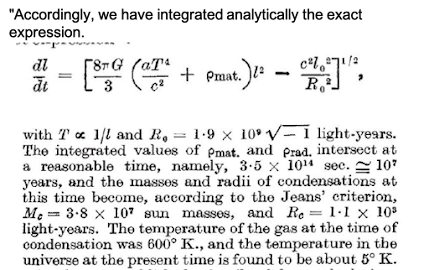I took Sociology 304 Research Methods in the spring of 2007. The professor was Young S. Kim. We were assigned to review two research papers each week. In the first class meeting, Dr. Kim said that these were not to be summaries but must be criticisms. After class, I approached his desk and asked if undergraduates could competently criticize a peer-reviewed publication. He replied, “Check the math.”
I do not know that I found any mathematical errors because I only archived three of my assignments from that class and none of those identified any such problems. However, a few months ago, researching an article for the American Astronomical Society, I found this from 1948:
- “Evolution of the Universe” by Ralph A. Alpher and Robert Herman, Nature, No. 4124 ,Vol. 162, November 13, 1948 identified errors in
- “The Evolution of the Universe” by George Gamow, Nature, No. 4122, Vol. 162, October 30, 1948.
(At that time, Alpher and Herman were doctoral candidates and Gamow was their advisor. Earlier that year, Physical Review published "The Origin of Chemical Elements" by Ralph Alpher, Hans Bethe, and George Gamow. Although he checked their math on a computer at the National Bureau of Standards, Robert Herman declined to belisted as "Delter." (Wikipedia citing Gamow here: https://en.wikipedia.org/wiki/Alpher%E2%80%93Bethe%E2%80%93Gamow_paper )
“The condensation-mass obtained from this corrected density comes out not much different from Gamow's original estimate. However, the intersectionpoint rmat. = rrad. occurs at t=8·6 x 1017 sec. ≅ 3 x 1010 years (that is, about ten times the present age of the universe). This indicates that, in findingthe intersection, one should not neglect the curvature term in the general equation of the expanding universe. In other words, the formation ofcondensations must have taken place when the expansion was becoming linear with time.”
For more on Young S. Kim see:
Kim, Y. S., Barak, G., & Shelton, D. E. (2009). Examining the “CSI-effect” in the cases of circumstantial evidence and eyewitness testimony: Multivariate and path analyses. Journal of Criminal Justice, 37(5), 452–460. https://doi.org/10.1016/j.jcrimjus.2009.07.005
https://psycnet.apa.org/record/2009-15801-001
Previously on NecessaryFacts
Imaginary Numbers are Real; Pegasus is Not
Two Books on Fermat’s Last Theorem
Elisha Loomis and the Pythagorean Proposition

No comments:
Post a Comment
Note: Only a member of this blog may post a comment.